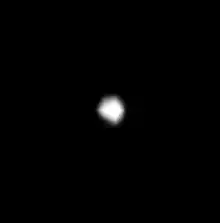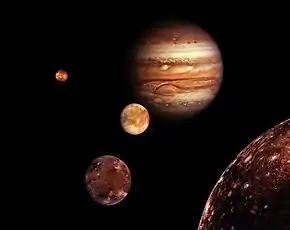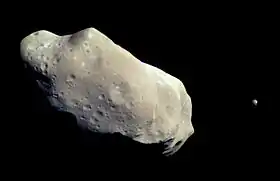Bianca (moon)
Bianca is an inner satellite of Uranus. It was discovered from the images taken by Voyager 2 on January 23, 1986, and was given the temporary designation S/1986 U 9.[8] It was named after the sister of Katherine in Shakespeare's play The Taming of the Shrew. It is also designated Uranus VIII.[9]
- There is also an asteroid called 218 Bianca.
 | |
| Discovery | |
|---|---|
| Discovered by | Bradford A. Smith / Voyager 2 |
| Discovery date | January 23, 1986 |
| Designations | |
Designation | Uranus VIII |
| Pronunciation | /biˈæŋkə/[1] |
| Adjectives | Biancan[2] |
| Orbital characteristics | |
Mean orbit radius | 59,165.550 ± 0.045 km[3] |
| Eccentricity | 0.00092 ± 0.000118[3] |
| 0.434578986 ± 0.000000022 d[3] | |
| Inclination | 0.19308 ± 0.054° (to Uranus' equator)[3] |
| Satellite of | Uranus |
| Physical characteristics | |
| Dimensions | 64 × 46 × 46 km[4] |
Mean radius | 25.7 ± 2 km[4][5][6] |
| ~8300 km²[lower-alpha 1] | |
| Volume | ~71,000 km³[lower-alpha 1] |
| Mass | ~9.2×1016 kg[lower-alpha 1] |
Mean density | ~1.3 g/cm³ (assumed)[5] |
| ~0.0086 m/s²[lower-alpha 1] | |
| ~0.022 km/s[lower-alpha 1] | |
| synchronous[4] | |
| zero[4] | |
| Albedo | |
| Temperature | ~64 K[lower-alpha 1] |
Bianca belongs to Portia Group of satellites, which also includes Cressida, Desdemona, Juliet, Portia, Rosalind, Cupid, Belinda and Perdita.[7] These satellites have similar orbits and photometric properties.[7] Other than its orbit,[3] radius of 27 km,[4] and geometric albedo of 0.08[7] virtually nothing is known about it.
At the Voyager 2 images Bianca appears as an elongated object, the major axis pointing towards Uranus. The ratio of axes of the Bianca's prolate spheroid is 0.7 ± 0.2.[4] Its surface is grey in color.[4]
See also
References
Explanatory notes
- Calculated on the basis of other parameters.
Citations
- Benjamin Smith (1903) The Century Dictionary and Cyclopedia
- Ruud (2008) Critical companion to Dante: a literary reference to his life and work
- Jacobson, R. A. (1998). "The Orbits of the Inner Uranian Satellites From Hubble Space Telescope and Voyager 2 Observations". The Astronomical Journal. 115 (3): 1195–1199. Bibcode:1998AJ....115.1195J. doi:10.1086/300263.
- Karkoschka, Erich (2001). "Voyager's Eleventh Discovery of a Satellite of Uranus and Photometry and the First Size Measurements of Nine Satellites". Icarus. 151 (1): 69–77. Bibcode:2001Icar..151...69K. doi:10.1006/icar.2001.6597.
- "Planetary Satellite Physical Parameters". JPL (Solar System Dynamics). 24 October 2008. Archived from the original on 17 January 2009. Retrieved 12 December 2008.
- Williams, Dr. David R. (23 November 2007). "Uranian Satellite Fact Sheet". NASA (National Space Science Data Center). Retrieved 12 December 2008.
- Karkoschka, Erich (2001). "Comprehensive Photometry of the Rings and 16 Satellites of Uranus with the Hubble Space Telescope". Icarus. 151 (1): 51–68. Bibcode:2001Icar..151...51K. doi:10.1006/icar.2001.6596.
- Smith, B. A. (1986-01-27). "Satellites and Rings of Uranus". IAU Circular. 4168. Retrieved 2011-10-31.
- "Planet and Satellite Names and Discoverers". Gazetteer of Planetary Nomenclature. USGS Astrogeology. July 21, 2006. Retrieved 6 August 2006.


